Ephesus: Ephesus was an ancient Greek city that ping-ponged back and forth between domination by various rulers until it achieved some stability as part of the Roman Empire. After the fall of the Roman Empire and the silting up of its port, it dwindled out of existence. Today it is an amazing archaeological site
near Selcuk, Turkey.
About 560 BC, Ephesus was conquered by king Croesus and the Lydians. The Ionians (an area in central coastal Anatolia, including Ephesus) refused a peace offering from Cyrus the Great of Persia, and sided with the Lydians. The Persians later defeated the Lydians and defeated Ephesus in 547 BC. The Greek cities of Asia Minor were incorporated into the Achaemenid Empire. The Ephesians participated in the Ionian Revolt against Persian rule in the Battle of Ephesus in 498 BC, which instigated the Greco-Persian wars. In 479 BC, with the help of Athens and Sparta, the Ionians ousted the Persians from the shores of Asia Minor and the next year entered into the Delian League (an association of 173 Greek city-states under the leadership of Athens) against the Persians. Around 413 BC, toward the end of the Peloponnesian War, after Ephesus sided with Sparta, which received support from Persian, Ephesus again came under the domination of the Persians. After Alexander the Great defeated the Persians at the Battle of Granicus in 334 BC, Ephesus and the other Greek cities of Asia Minor were liberated. In 290 BC, following Alexander’s death in 323 BC, Ephesus came under the rule of Lysimachus (his bust, from the archaeological museum),
one of Alexander’s generals. In 281 BC, Lysimachus was killed by Seleucus I Nicator at the Battle of Corupedium and Ephesus became part of the Seleucid Empire. Ptolemy III invaded the Seleucid Empire and swept the coast of Asia Minor and Ephesus was under Egyptian rule from 263 to 197 BC. The Seleucid king Antiochus III the Great tried to regain the Greek cities of Asia Minor and came in conflict with Rome. Antiochus was defeated by the Roman Scipio at the Battle of Magnesia in 190 BC and Ephesus went under the rule of the Attalid king of Pergamon Eumenes II. His grandson, Attalus III, died without male children and left his kingdom to the Roman Republic. Taxes went up and the treasures of the city were plundered. So in 88 BC, when Mithridates the Great, king of Pontus (the Roman name for western Asia Minor) conquered Asia, Ephesus welcomed his general Archelaus. For a short time, Ephesus was self governed, but when Mithridates was defeated in the First Mithridatic War by the Roman Lucius Cornelius Sulla, in 86 BC, Ephesus was again under Roman rule. Sulla imposed a huge indemnity and five years of back taxes which left Ephesus in debt for a long time. When Augustus became emperor in 27 BC, he made Ephesus the capital of proconsular Asia, instead of Pergamum, and Ephesus entered an era of prosperity. By 100 AD, Ephesus had 400,000 to 500,000 inhabitants. A bust of Marcus Aurelius from the 2nd century AD.
The city was destroyed by the Goths in 263 AD, marking its decline.
Constantine rebuilt much of the city
and it remained the most important city in the Byzantine Empire, after Constantinople, in the 5th and 6th centuries. Ephesus was partially destroyed by an earthquake in 614
and its importance as a commercial center declined as the harbor silted up by the river and it lost its access to the Aegean Sea.
When the Seljuk Turks conquered Ephesus in 1090, it was just a small village.
The Temple of Artemis: The Temple of Artemis was a Greek temple dedicated to the goddess Artemis, twin of Apollo. To the Romans, Artemis was known as Diana. Construction of the temple, which was to become one of the seven wonders of the ancient world, began about 550 BC in Ephesus. It took 120 years to build. Pliny described the temple as 377 feet long and 180 feet wide, made almost entirely of marble. It was almost three times as large as the Parthenon and Pausanias, in the 2nd century AD, said it was the largest building in the world. The cella was enclosed by Ionic columns, 60 feet tall. It was destroyed on July 21, 356 BC, the day Alexander the Great was born, by Herostratus, an act of arson. Plutarch wrote that Artemis was too preoccupied with Alexander’s delivery to save her burning temple. Alexander later offered to pay for the temple’s rebuilding, but the Ephesians refused. It was eventually restored after Alexander’s death, in 323 BC. The temple was destroyed again in a raid by the Goths in 268 AD, and it was rebuilt again. In 391, Theodosius closed all temples and in 401, St. John Chrysostom, Archbishop of Constantinople, led a mob that destroyed the last version of the temple. The marble of the temple was raided for use in other structures, including columns which were taken to Constantinople and used in the construction of the Hagia Sophia, construction of which was begun under Justinian after 532 AD. In modern times, the site of the temple was discovered in 1869 after 60 years of searching. Some of the remaining fragments are now found in the British Museum and very little remains at the site, just outside Selcuk, Turkey. Unfortunately, we did not have the opportunity to visit this site.
Apostle Paul in Ephesus: Paul went to Ephesus in about 52 or 53 AD and spent three months going to the synagogue, “disputing” with the Jews and trying to persuade them in “things concerning the kingdom of God.” When their hearts “hardened, and believed not,” he disputed daily with the Greeks “in the school of one Tyrannus.” This continued for two years. (Acts 19:1,8-9) Paul, through God, “wrought special miracles” while in Ephesus. People would take handkerchiefs or aprons that belonged to Paul and use them to heal the sick or get evil spirits to depart. Eventually, Paul’s view on idols got him in trouble. The Temple of Artemis brought people from all over the known world. “Demetrius, a silversmith” who “made silver shrines for Diana,” the Roman name for Artemis, called together “the workmen of like occupation” into the theater at Ephesus. He reminded them that their craft provided them with wealth and Paul was turning many people away from the worship of Diana, telling them there were “no gods…made with hands.” Demetrius was concerned that “the temple of the great goddess Diana” would be “despised, and her magnificence…destroyed,” and their “craft” which provided their livelihoods was going “to be set at nought.” The craftsmen were “full of wrath, and cried out, saying, Great is Diana of the Ephesians.” Paul was warned by his disciples not to enter the theater and the town clerk “appeased the people,” saying, “Ye men of Ephesus,” you know “that the city of the Ephesians is a worshipper of the great goddess Diana, and of the image which fell down from Jupiter. Seeing…that these things cannot be spoken against, ye ought to be quiet, and to do nothing rashly.” If “Demetrius, and the craftsmen which are with him, have a matter against any man, the law is open, and there are deputies: let them implead one another…[W]e are in danger to be called in question for this day’s uproar, there being no cause whereby we may give an account of this concourse.” After so speaking, the town clerk “dismissed the assembly.” Following the uproar, Paul “embraced” his disciples and departed for Macedonia. (Acts 19:24-41; and 20:1)
Paul wrote his First Epistle to the Corinthians, a letter to the members in Corinth, Greece, while he lived in Ephesus (1 Cor. 16:8). He lived in Ephesus approximately three years (Acts 19:8, 19:10, and 20:31) after he founded the church in Corinth (Acts 18:1-17). Paul later wrote his Epistle to the Ephesians while he was in prison in Rome, around 62 AD, although many scholars believe that the Epistle to the Ephesians was written 20 to 30 years later (between 80 and 100 AD) by one of Paul’s disciples and not Paul, himself.
Ephesus was one of the seven cities of Asia mentioned in Revelations (Rev. 2:1-7) and it is possible that the Gospel of John was written there. The Church of Mary, close to the harbor of Ephesus, was the setting for the Third Ecumenical Council of the early Christian Church, held in 431. Nestorius, Patriarch of Constantinople, put forth the doctrine that there was disunity between Christ’s human and divine natures. Cyril, Patriarch of Alexandria, opposed him and the position of Nestorius was condemned. This started the Nestorian Schism. There was also a Second Council of Ephesus in 449. The west was not well represented and the acts of the council were not approved of by the Catholics. It later became known as the Robber Council and its acts were overturned by the Council of Chalcedon, today a suburb in Istanbul, in 451.
Ruins of Ephesus: Only about 15% of the ruins at Ephesus have been excavated.
The Library of Celsus, with an amazing façade,
which once housed 12,000 scrolls,
was built in 125 AD, after the time of Paul.
The monumental gate next to it, the South Gate of Agora, also known as Mazeus – Mithridates Gate, with three passages,
dates from the 1st century BC.
The Odeon, a small roofed theater, was a small salon for plays and concerts and seated about 1,500 people.
It was built in 150 AD, also after Paul’s time there.
The Temple of Artemis existed at the time of Paul, some distance from the current Ephesus archaeological site, but there is now virtually nothing that remains. A statue of Artemis from the 2nd century AD housed in the archaeological museum.
A closeup of the statue.
A fountain built to honor the Emperor Trajan,
was built between 102 and 114 AD.
A bust of Trajan from the archaeological museum.
The Temple of Hadrian
was built in the 2nd century AD
and had repairs in the 4th century.
The Temple of Domitian,
Roman Emperor from 81 to 96 AD
(his bust from the archaeological museum),
was also built after the time of Paul.
It was very impressive and I would love to see it put back together someday.
The Memmius Monument, dedicated to the Roman dictator Sulla’s grandson, is from the 1st century BC, and existed at the time of Paul.
The figures on the monument are Memmius, his father Caius and his grandfather Sulla.
The bath was built in the 1st century AD.
It was repaired in the 4th century by a woman named Skolastikia and that is where it gets its name. It is next to the latrine which I believe is also from the same time period. They apparently were not shy in those days about taking care of busines.
Curetes Street dates from the 2nd century BC and was covered, the columns at the side providing support for the roof.
It was partially lined with shops, inns, artisan workshops and trade offices. It was also the Sacred Way leading to the Temple of Artemis. Heracles Gate was along Curetes Street.
The Marble Street was a section of the Sacred Way between the theater and Hadrian's Gate.
It was completely covered with white marble. The theater, which exists from 100 BC or earlier, also existed at Paul’s time and figures in the story of Demetrius and the silversmiths.
However, it was a smaller version than the one that exists now,
which holds an estimated 44,000 people and was the largest outdoor theater in the ancient world, as the original theater was expanded with time.
Sources: Selabattin Erdemgil, The Essential Visitor’s Guide: Ephesus (Net Turistik Yayinlar: 2010); Wikipedia “Council of Chalcedon,” “Delian League,” “Diana (mythology),” “Ephesus,” “Epistle to the Ephesians,” “First Council of Ephesus,” “First Epistle to the Corinthians,” “Hagia Sophia,” “Ionia,” “John Chrysostom,” “Peloponnesian War,” “Second Council of Ephesus,” “Seven churches of Asia,” “Temple of Artemis”





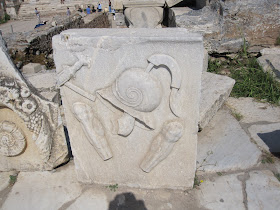



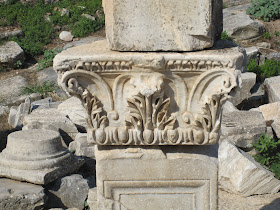



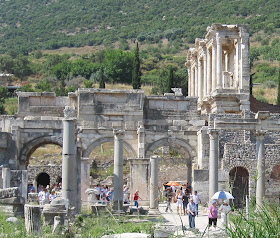
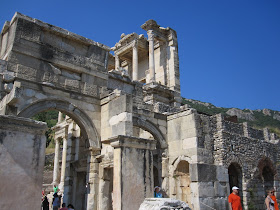








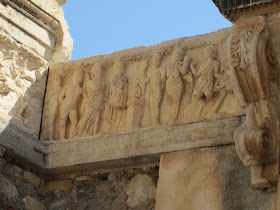










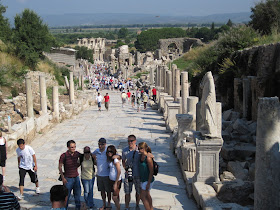





Those old emperors all need rhinoplasty. Other than that, this was an amazing place.
ReplyDeleteP.S. Obviously men designed and built that communal bathroom. Women would have put in sinks and mirrors.
ReplyDeleteIf ever I go here, I will just set up a detailed re-reading of this blog.
ReplyDeleteP.S. And plugs for the blow-dryers.
Olağanüstü güzel. İlk gördüğümde çakılıp kalmıştım karşısında. Bir sanat tarihçisi olarak tüm tarafsızlığımla ve gönül rahatlığıyla söyleyebilirim ki tüm Türkiye coğrafyası muhteşem tarihi eserlerle dolu. Göbeklitepe başta olmak üzere, ülkemin her yerinde ayrı bir tarihi değer mevcut. Kimisi gizli, kimisi ortada. Ama görülmeden ölünmemeli. Çok güzel.
ReplyDelete